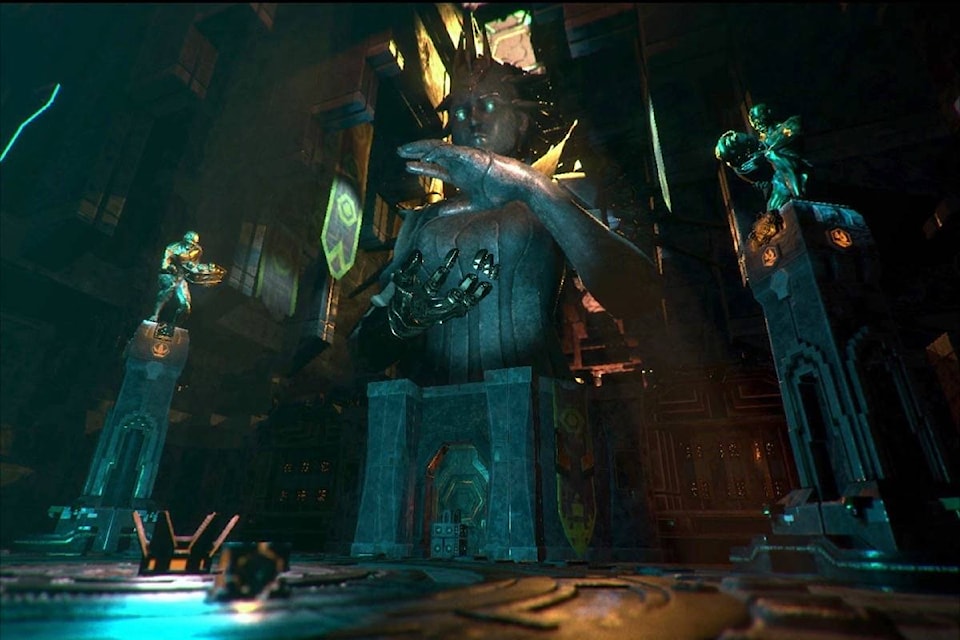This is the second in a two-part series on Qualicum Beach’s resident virtual reality (VR) company, Cloudhead Games, and its second game.
In this instalment, The NEWS delves into the reception of the second game, The Gallery Ep. 2, Heart of the Emberstone, how the VR industry is doing, and where it’s going.
To read part one of the story, see Tuesday, Dec. 26th’s edition of The NEWS, or view it online at www.pqbnews.com.
So far, Heart of the Emberstone’s reception has been very positive, mimicking the reception of the first episode. Online reviews show The Gallery games are two of the most immersive experiences players can have with VR, making it easy for players to forget where they actually are, and feel as if they are inside the world of the game. And that sensation is what VR is all about.
By strapping on a set of goggles, a VR player’s entire field of view is the game. Positionally tracked controllers and goggles allow the player to move around in the game by actually moving around. A game’s ability to be immersive is about a lot of things, including having a virtual game world that is detailed and engaging, and uses game mechanics that let the player move around in a natural-feeling way.
Episode 2 also fixes one of the gripes with the first episode — it takes longer to finish at about five hours.
“We honestly didn’t know what to expect, and that mirrors what happened with the first episode,” company CEO Denny Unger said of Heart of the Emberstone’s reception. “We couldn’t ask for more, there,” he said. “The VR market as a whole, though, is a different kind of story.”
Right now, a good VR setup costs hundreds of dollars, and in some cases more than $1,000 if you don’t already have the high-end computer needed for the HTC Vive and the Oculus Rift, which The Gallery episodes use.
Nonetheless, many people are hearing about what VR can do, and are buying cheap VR headsets.
“If you walk into (an electronics store) right now, you’ll see a wall of VR devices, and they’re all s---,” said Unger. People tend to get that as their first experience, and then they think, ‘Oh, VR is a gimmick. Why would I want to invest money in that or play a game in that?’”
The thing is, said Unger, the tech is amazing and can offer amazing experiences.
“But it’s still costly,” he said. “It’s fighting a kind of a PR war with the public, because a lot of the public hasn’t had a chance to try high-end VR. And that’s Oculus, that’s Vive, that’s PSVR,” said Unger, naming the three high-end, consumer-ready VR products now available.
“So that’s the biggest thing we have to get over — and we will,” he said.
Some VR companies, Cloudhead Games included, feel there is more VR can offer, that it’s not just about video games. Unger said he has a pretty good idea about what the future of the technology can be, and Cloudhead Games is working on getting there.
They, and other VR companies, just have to convince Hollywood, which is proving to be tough.
“One of the things we’ve learned is that it’s hard to define VR games as games,” he said. “It’s like some weird hybrid of live-theatre and interactive media. It’s more like being a central character in a story where you do have some agency and you can interact.”
A lot of VR “gaming” companies have taken to calling what they make “experiences” for just that reason.
So, Cloudhead Games and other studios are talking with Hollywood production companies in the hopes of making a cinematic experience into one that people don’t just passively watch from a seat in a theatre, but one they experience in the world of the movie, and can even interact with.
“They (production companies) are trying to get their heads around what it means to make a movie for VR,” said Unger. “Is that relevant? Does it work?”
But many studios, as they learn about VR and the amount of work, money and research and development a VR movie might take, tend to back off, said Unger.
“They come to us excited, we pitch, they get excited about that, but when it comes down to actually footing the bill for that thing, it’s more of a problem,” he said, adding that studios also often come to them too late because they don’t understand the work involved in creating an interactive VR world.
Also, said Unger, movie studios generally come to Cloudhead and others asking them to create something that can help to promote a movie. But the future Unger sees is the VR experience being the whole idea. Some in Hollywood are starting to see that, too, he said.
“There’s some exciting people we’re talking to right now, and it could be great,” he said.
